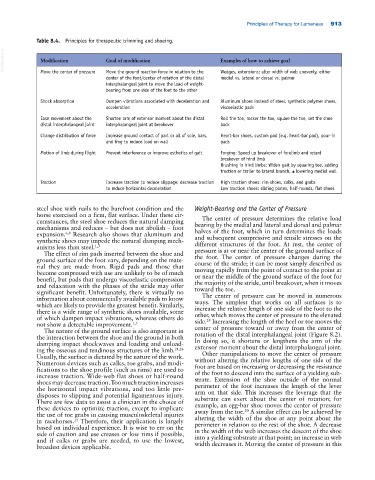Page 947 - Adams and Stashak's Lameness in Horses, 7th Edition
P. 947
Principles of Therapy for Lameness 913
Table 8.4. Principles for therapeutic trimming and shoeing.
VetBooks.ir Modification Goal of modification Examples of how to achieve goal
Move the center of pressure
Move the ground reaction force in relation to the
center of the foot/center of rotation of the distal Wedges, extensions; alter width of web unevenly, either
medial vs. lateral or dorsal vs. palmar
interphalangeal joint to move the load of weight‐
bearing from one side of the foot to the other
Shock absorption Dampen vibrations associated with deceleration and Aluminum shoes instead of steel, synthetic polymer shoes,
acceleration viscoelastic pads
Ease movement about the Shorten arm of extensor moment about the distal Roll the toe, rocker the toe, square the toe, set the shoe
distal interphalangeal joint interphalangeal joint at breakover back
Change distribution of force Increase ground contact of part or all of sole, bars, Heart‐bar shoes, custom pad (e.g. heart‐bar pad), pour‐in
and frog to reduce load on wall pads
Motion of limb during flight Prevent interference or improve esthetics of gait Forging: Speed up breakover of forelimb and retard
breakover of hind limb
Brushing in hind limbs: Widen gait by squaring toe, adding
traction or trailer to lateral branch, ± lowering medial wall
Traction Increase traction to reduce slippage; decrease traction High traction shoes: rim shoes, calks, and grabs
to reduce horizontal deceleration Low traction shoes: sliding plates, half‐rounds, flat shoes
steel shoe with nails to the barefoot condition and the Weight‐Bearing and the Center of Pressure
horse exercised on a firm, flat surface. Under these cir- The center of pressure determines the relative load
cumstances, the steel shoe reduces the natural damping
mechanisms and reduces – but does not abolish – foot bearing by the medial and lateral and dorsal and palmar
halves of the foot, which in turn determines the loads
6,8
expansion. Research also shows that aluminum and
synthetic shoes may impede the natural damping mech- and subsequent compressive and tensile stresses on the
different structures of the foot. At rest, the center of
anisms less than steel. 1,3
The effect of rim pads inserted between the shoe and pressure is at or near the center of the ground surface of
ground surface of the foot vary, depending on the mate- the foot. The center of pressure changes during the
rial they are made from. Rigid pads and those that course of the stride; it can be most simply described as
moving rapidly from the point of contact to the point at
become compressed with use are unlikely to be of much
benefit, but pads that undergo viscoelastic compression or near the middle of the ground surface of the foot for
the majority of the stride, until breakover, when it moves
and relaxation with the phases of the stride may offer
significant benefit. Unfortunately, there is virtually no toward the toe.
The center of pressure can be moved in numerous
information about commercially available pads to know
which are likely to provide the greatest benefit. Similarly, ways. The simplest that works on all surfaces is to
increase the relative length of one side of the foot to the
there is a wide range of synthetic shoes available, some
of which dampen impact vibrations, whereas others do other, which moves the center of pressure to the elevated
side. Increasing the length of the heel or toe moves the
28
not show a detectable improvement. 1,3
The nature of the ground surface is also important in center of pressure toward or away from the center of
the interaction between the shoe and the ground in both rotation of the distal interphalangeal joint (Figure 8.2).
damping impact shockwaves and loading and unload- In doing so, it shortens or lengthens the arm of the
extensor moment about the distal interphalangeal joint.
ing the osseous and tendinous structures of the limb. 21,26
Other manipulations to move the center of pressure
Usually, the surface is dictated by the nature of the work. without altering the relative lengths of one side of the
Numerous devices such as calks, toe grabs, and modi-
fications to the shoe profile (such as rims) are used to foot are based on increasing or decreasing the resistance
of the foot to descend into the surface of a yielding sub-
increase traction. Wide‐web flat shoes or half‐round
shoes may decrease traction. Too much traction increases strate. Extension of the shoe outside of the normal
perimeter of the foot increases the length of the lever
the horizontal impact vibrations, and too little pre-
disposes to slipping and potential ligamentous injury. arm on that side. This increases the leverage that the
substrate can exert about the center of rotation; for
There are few data to assist a clinician in the choice of
these devices to optimize traction, except to implicate example, an egg‐bar shoe moves the center of pressure
away from the toe. A similar effect can be achieved by
20
the use of toe grabs in causing musculoskeletal injuries
in racehorses. Therefore, their application is largely altering the width of the shoe at any point about the
14
perimeter in relation to the rest of the shoe. A decrease
based on individual experience. It is wise to err on the
side of caution and use creases or low rims if possible, in the width of the web increases the descent of the shoe
into a yielding substrate at that point; an increase in web
and if calks or grabs are needed, to use the lowest,
broadest devices applicable. width decreases it. Moving the center of pressure in this

